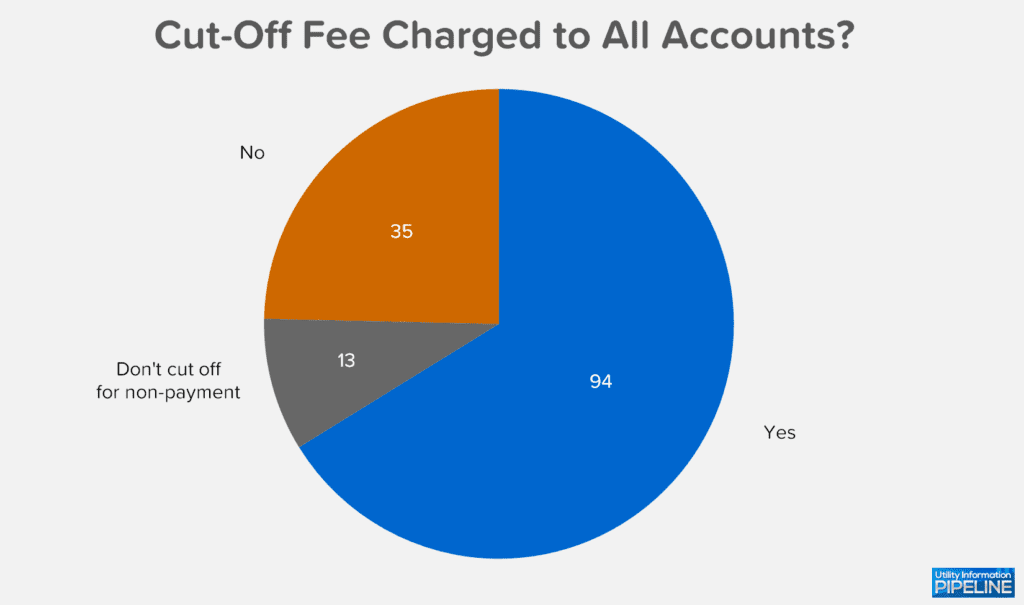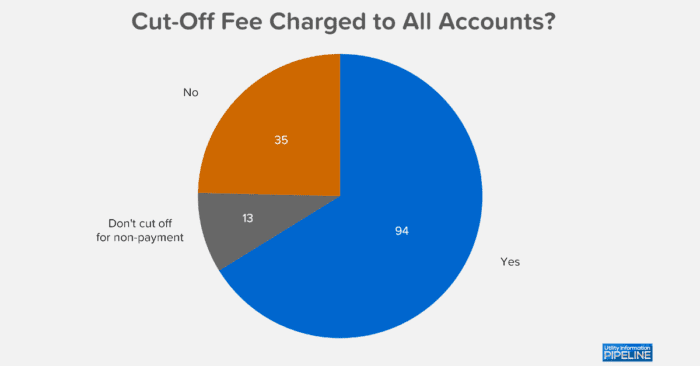I’ve seen two related scenarios lately which merit discussing in more detail.
The first case was a business review I recently completed for a utility that charges their cut-off fee as two separate charges – a cut-off fee, then a reconnect fee for customers who are reconnected.
Poll question
The second occurred during my Improving Revenue Collections for Utilities presentation at a conference. This particular conference made use of an app where participants could respond in real-time to polls. One of my poll questions was “Does your utility charge the cut-off fee to all accounts when the cut-off list leaves the office?”
I was very surprised to learn that only 42% of the participants represented utilities that charge the cut-off fee to all accounts when the cut-off list leaves the office.
Utility Fee Survey results
From the 2021 Utility Fee Survey, 94 of the 142 (representing 66.2%) responding utilities do follow the best practice of charging the cut-off fee to all accounts when the cut-off fee leaves the office, as show in this graph (clicking on the graph will open a larger image in a new window).

Removing the 13 utilities that do not cut off for non-payment increases the percentage to 72.9% (94 of 129 utilities). This is an increase of 8.5% from the 2019 Utility Fee Survey.
A step back in time
To examine how the two situations are related, let’s go back in time. When I first started in this business, most utilities only charged the cut-off fee if the customer had been cut off. This predated utilities accepting credit cards (I’ve been doing this for a very long time!), so customers on the cut-off list had to come into the office to pay. When a customer came in to pay, the cashier would have to radio the technician in the field (this also predated cell phones that weren’t installed in a vehicle!) to see if the customer had been cut off. If they had, they were charged the cut-off fee, if not, no fee was assessed.
As you might imagine, this was terribly inefficient and very disruptive to both cashiers and field service technicians, not to mention the embarrassed customer who had to wait for a response from the field before knowing how much to pay
A best practice evolved
From all this confusion, what has become a best practice of charging the cut-off fee to every account on the cut-off list at the time the list leaves the office evolved. This is a simpler, more equitable solution that saves considerable time and effort for the utility staff.
How are the two situations related?
In the first scenario, the initial cut-off fee is assessed to all accounts, but the follow-up reconnect fee is only charged if the account had been disconnected. This is only a slight improvement over charging the entire fee only to those accounts that have been cut off.
To better understand why charging the fee to all accounts even before they have been cut off, here are some of the reasons this has become a best practice:
Equitable to all customers
Here’s an illustration I use when I present this topic at conferences. Is it really fair for your customers who live farther away from the office to have more time to pay? By the time a customer ends up on the cut-off list, they have exhausted all attempts by the utility to encourage them to pay. Just because a friend or neighbor alerts them that cut-offs are happening today, should they avoid paying the fee simply because the field service technician hasn’t yet arrived at their home? I would make the strong case they should not.
Limits confusion
By eliminating the need to contact the field service technician each time a customer on the cut-off list comes in to pay, it speeds up the payment process and allows the field staff to focus on finishing the cut-off list with no interruptions.
Improves efficiency
If you assess the fee to only those accounts who have been disconnected, the fee must be applied manually to each account. On the other hand, if you charge it to all accounts, you can take advantage of the cut-off process in your billing software and have the system charge it to all accounts on the cut-off list.
If you offer online bill pay, an added benefit is the payment portal will have the total due, including cut-off fee, if the customer opts to pay online. This means you won’t get a phone call when the next bill goes out having to explain why there is a cut-off fee on the account from the previous month, which is the case if the fee is added after the online payment takes place.
Generates more revenue
By charging the cut-off fee to every account on the cut-off list, more revenue is generated. That’s hard to argue with!
Are your cut-off policies out-of-date?
If your cut-off policies and procedures are outdated, please give call me at 919-673-4050 or email me at gary@utilityinformationpipeline.com to learn how a business review could help you review all of your policies and procedures.
2022 Utility Staffing Survey
There’s still time to complete the 2022 Utility Staffing Survey, if you haven’t already participated.
If you’d like to complete the 2022 Utility Staffing Survey, please click here. This should only take a few minutes to complete and I will publish the results in future newsletters.
Thank you in advance for taking the time to complete the survey and please feel free to share it with your peers at other utilities.

© 2022 Gary Sanders
